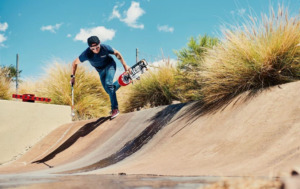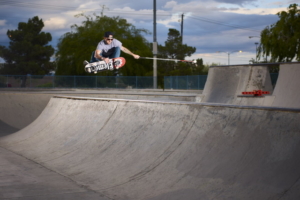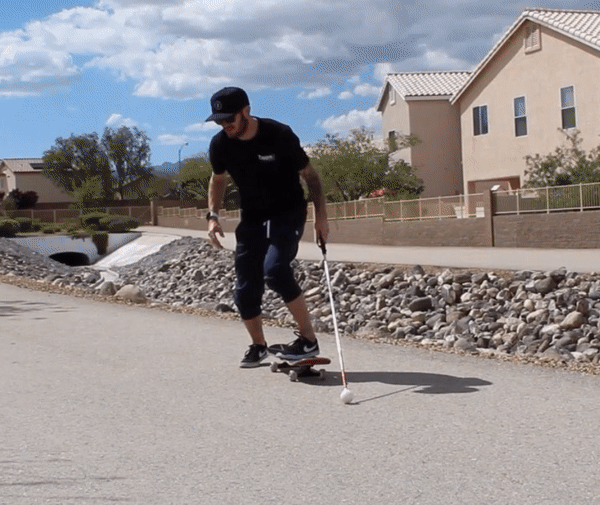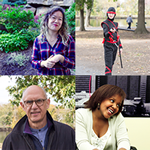Faces Behind the Screen: Justin Bishop
Quick Links
<< Return to all “Faces Behind the Screen” stories

Photo by Saeed Rahbaran
“And around that time, I gave up skateboarding and learned how to be fully blind.”
Justin Bishop is a skateboarder through and through. Even when he lost his vision, he refused to give up his greatest passion: skateboarding. We had the opportunity to chat with Justin about what it’s like to skateboard blind. Check out part one of the interview below and stay tuned for more.
How do you identify in terms of your vision loss?
JUSTIN BISHOP: I’m almost fully blind. I have a condition called retinitis pigmentosa. I have no vision in my left eye, and then in my right eye, my retina has detached. So I have no central vision. It’s just black in front of me. Then on my peripheral, I can see some shapes and some shadows within like 10 feet or so – but it has to be high-contrast, really bright. If it’s dark, then there’s no way I can see the shadow. But that’s where I’m at right now.
Whenever I talk about it or identify, I say blind slash visually impaired. I do the slash because people don’t understand that there is a spectrum to being blind. So I lump them together so that you have to think about both aspects of it. I’ve been losing my vision since I was about 10, and I’ve always been low vision or visually impaired.
How did you first get into skateboarding and what has your journey been like coming back?
JUSTIN BISHOP: I got into skateboarding mainly because it was something I could do alone. With other sports, you have to have a meeting, you have to meet up with the team, you have to have a coach. It was just too much and too structured. As a kid, it was just easy to just pick up a skateboard and just go skate, whenever you want and how long you wanted. So it was more just about the independence of skateboarding when I got into it.
I would say the journey of losing my sight and skateboarding has been a roller coaster. When I had vision I was a high-performing skateboarder. Then from the age of 20 to 25, I lost a majority of my sight. So I was just losing all this skill and talent that I practiced and that I gained from 10 years of skateboarding. I just lost it, over the course of a year. Then losing my eyesight, too. It was kind of a depressing time.
Around that time, I gave up skateboarding and learned how to be fully blind – a lot of cane and mobility training, a lot of tactile training, and Braille grade 1 training, stuff like that. Then, when I had my life down as being blind, I just kind of picked up skateboarding again, and fell in love with it all over again. I fell in love with learning how to do it, and I didn’t care that I had to relearn everything. It was such a joy that it was worth relearning it twice.
What type of assistive devices do you use to help you while skating?
JUSTIN BISHOP: So right upfront, I use the white cane. I use [the white cane] every day. Pretty much the only time I don’t use it is in my own home. But besides that, it’s always in my hand. In my day-to-day, it just helps me get around a lot faster and more confidently.
When I’m skating, the white cane will tell me directly what’s in front of me. Then I also use something called a beeper box. It’s an audible beeping marker, and I found it because other blind sports use it. I realized that I can use this for skateboarding and that I can set it up at an obstacle to know where I’m at in the surrounding area. It’s just pretty much a little box that beeps that you can just turn on.
So I was using that to skate, and Zappos kind of saw one of my videos using it, and they do a program with Not Impossible Labs, and they actually made something called a phased array speaker system. It’s pretty much a beeper box on steroids. So I can actually change the direction of the sound. I can make a wall of sound. I can manipulate sound in all these crazy ways. So I’ve been using that a lot more to skate.
Is there a learning curve for you when you are going to a new skate park?
JUSTIN BISHOP: Yeah. If it’s a place I’ve never been to before, it usually takes me about 40 minutes before I can start skating. I’ll walk the course or walk the park with my cane, and kind of feel it out, feel what I want to do. That usually takes about 40 minutes. Then I’ll lay down my beeper boxes, or lay down one of them and skate an area, or kind of like work up from there. It usually takes a little bit for me to explore and get used to a park.
What is it like having vision loss in the skateboarding community?
JUSTIN BISHOP: Yeah, so right now, there’s two of us, like higher-performing blind skateboarders. The other guy, his name is Dan Mancina. He’s a really, really cool guy. We actually have the same condition, we’re the same age, and we love to skateboard. So it’s kind of crazy that we get to meet. We’ve met, and got to skate together.
As for the skateboard community, it’s the best community to be in. People are just loving, so kind, so caring. I honestly believe that if any other skateboarder lost their vision, they’d be doing what I do. They’d still be skateboarding. Because when you get into skateboarding, you just have a love for it. And you can pick up that love from other people, and you just know it. So I think definitely in the skateboarding community, they just see the passion, and they would know, yes, I’d be doing the same thing if I lost my sight. And I think that’s why it’s such a tight-knit and sharing community.

Photo by Saeed Rahbaran
When it comes to technology, what are some everyday obstacles that you run into that sighted people might often take for granted?
JUSTIN BISHOP: I would say social media. A lot of photos– it’s crazy that both social media platforms, Facebook and Instagram, have integrated the ability to make every photo accessible, and it’s just not. So not being able to share in the human experience of social media as fluidly as the average person – that’s a big one. Nothing’s labeled with voiceover, nothing’s labeled correctly. So I would say the internet is probably my best friend and my worst enemy at times.
I’ll use the screen reader. Everything in my house is Mac or Apple, so everything has voiceover on constantly. My Apple TV, my Apple Watch, phone, computer, everything has voiceover on. So I can just easily interact with the iOS and apps that are integrated with voiceover.
And then for audio description, another thing that I use is– Apple is amazing with accessibility. So iTunes, every new movie has audio description, Netflix is getting really good with audio description now. And so one thing I’m doing is that when I was losing my eyesight and wanted to be inspired or know what other blind athletes or blind people are doing, everything that was made about the blind was made for the sighted. And it really upset me and alienated me, even in my own community.
“And so I always get text messages or phone calls saying, yeah, I just threw on this movie with audio description, and I was doing laundry, I was doing work, and I didn’t have to lift my head up once. And I was like, see, so anybody can use it.”
So when I had any kind of social media influence, I started making everything on my Instagram accessible. So all my videos have audio description that my girlfriend puts together. She’ll write up a script, and we have a speaker upstairs, that she’ll use to do the audio description. Then we’ll throw it on my Instagram. And then every photo I post has alt-text for voiceover or talkback technology. I also put a picture description inside the comments, just in case people are curious or don’t use screen readers, but can’t really see what the photo is.
I like to force people to experience audio description. Everyone has been forced to know what closed captioning is, so everyone knows what that is. But nobody knows what audio description is. So I actually like forcing people to be like, oh, this is audio description because it exposes them to it so that they are aware that this is how blind people watch videos, or this is what’s needed more of.
One thing that I think is really cool, is I’ve exposed a lot of people to it, is that because it’s always on at my house, and it’s always on wherever I go, that people in my circle are exposed to it daily. And now they’re using it like closed captioning. Even though they’re not deaf or hard of hearing, you know, if you go to a gym or somewhere loud, you have closed captioning on. And so I always get text messages or phone calls saying, yeah, I just threw on this movie with audio description, and I was doing laundry, I was doing work, and I didn’t have to lift my head up once. And I was like, see, so anybody can use it.
And I think when people realize that it’s not just for the blind, that you can use it like closed captioning, it will grow faster and be more accessible everywhere.

Photo by Saeed Rahbaran
What advice would you give to content creators to make their websites and videos more accessible?
JUSTIN BISHOP: I would say label pictures, even if it’s just in the name. Because pictures read off. You know, like my voiceover cursor will be on a photo, and it will say “image,” and then all these million numbers. All you have to do is just rename the image, then boom, then you have– you don’t even have to do a picture description, just real fast, like just name it as “girl in front of building.” And then it gives me some idea. Or you can get more detailed. But even the littlest description is better than nothing.
Yeah, so I think that one, right off the bat, labeling stuff. Buttons are the worst. Like, online, it will just say, button. All you have to do is just label what that button does. Like is that the search button, id that the cancel button? So just labeling things correctly, taking three extra minutes to do it.
One thing I’ve been trying to tell people is that a lot of young people are blind. But everyone pretty much goes blind when they get older. And because it’s millennials and people that have grown up using computers, when these old people start losing their vision from macular degeneration or other age-related vision loss, because they’re so used to technology, they’re going to be leaning heavily on these voiceover options because they already know how to use technology. And so make your websites accessible now for them, so when they start having these problems and losing their vision, the websites are all ready. You won’t have to do a major remodel of your website because millennials are aging.
Faces Behind the Screen would like to thank Justin Bishop for participating in our storytelling project. If you’re interested in sharing your story with us, fill out our nomination form.
Faces Behind the Screen is a storytelling project focusing on members of the Deaf and hard of hearing community, as well as those who are blind and low vision.




